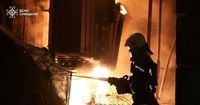In the early hours of August 27, 2025, the hum of generators replaced the usual buzz of daily life for more than 100,000 Ukrainian households. Across the Poltava, Sumy, and Chernihiv regions, residents woke to darkness after a barrage of Russian drone attacks targeted the country’s energy and gas transport infrastructure, according to Ukraine’s President Volodymyr Zelensky and the Ukrainian energy ministry. The strikes, which officials described as among the most intense in recent months, left not only homes but also key public services scrambling to restore power and maintain critical operations.
The overnight assault was sweeping in its reach. As Reuters reported, the attacks spanned six regions: Poltava, Sumy, Chernihiv, Kharkiv, Zaporizhzhia, and Donetsk. The Ukrainian Air Force said it managed to intercept and down 74 out of the 95 drones launched by Russia, but 21 drones still found their mark, striking nine locations across the country. The energy ministry detailed that in Poltava, gas transport infrastructure suffered significant damage, while in Sumy, essential equipment at a key substation was hit. Kharkiv, Zaporizhzhia, and Donetsk—regions already battered by months of conflict—were not spared from the overnight bombardment.
President Zelensky did not mince words when he addressed the nation via Telegram. "New steps are needed to put pressure on Russia to stop the strikes and truly guarantee security. We are working with partners for such pressure," he stated, underscoring the urgency of international support. He described the attacks as a continuation of Moscow's deliberate policy to destroy civilian infrastructure ahead of the looming winter, a sentiment echoed by the energy ministry, which said, "We regard the Russian attacks as a continuation of the Russian Federation's deliberate policy of destroying Ukraine's civilian infrastructure ahead of the heating season."
The humanitarian impact was immediate and widespread. In Poltava, the attacks temporarily cut off power to consumers, though Governor Volodymyr Kohut later confirmed that electricity had been restored. Sumy, however, faced a grimmer situation. Significant portions of the city remained without power, forcing water utility and healthcare facilities to rely on emergency backup generators. Serhii Kryvosheienko, head of the Sumy city military administration, noted that all water utility facilities and healthcare centers were operating on emergency backups as of Wednesday morning. The ripple effects of such outages—especially as Ukraine heads into colder months—are profound, affecting everything from basic hygiene to life-saving medical care.
But the damage extended beyond just the Poltava, Sumy, and Chernihiv regions. Ukraine’s main gas production facilities, located in Poltava and Kharkiv, were also targeted. The country has already faced a 40% drop in gas production since Russian missile strikes earlier in 2025, exacerbating concerns about energy security as winter approaches. The energy ministry revealed that since March 2025, Ukrainian energy facilities have been attacked an astonishing 2,900 times, painting a grim picture of the relentless assault on the nation’s infrastructure.
While the focus of the strikes was clearly on energy and gas facilities, the violence didn’t stop there. According to BBC, a school in the Kharkiv region and a high-rise building in Kherson were also hit, further highlighting the indiscriminate nature of the attacks. Russia, for its part, has consistently denied targeting civilians, maintaining that energy systems and other infrastructure are legitimate military targets because they support Ukraine's war effort. However, the mounting toll on civilian life and essential services tells a different story on the ground.
The attacks come at a time when the broader conflict shows no sign of abating. Three and a half years after Russia’s full-scale invasion of Ukraine, fighting remains fierce. On August 26, Ukrainian military officials acknowledged that Russian forces had, for the first time, crossed into the Dnipropetrovsk region. Fortunately, the advance was halted. Meanwhile, Russia’s defense ministry announced that its troops had seized a village in Donetsk, signaling continued gains in the region despite reportedly high casualties among Russian forces.
Diplomatic efforts to bring about a ceasefire have intensified in recent weeks. Earlier in August, U.S. President Donald Trump launched a new international initiative, meeting Russian President Vladimir Putin in Alaska and later convening with President Zelensky and European leaders in Washington. Trump has been advocating for a summit between Putin and Zelensky, a move that Zelensky supports but only with strong security guarantees from Western allies to prevent a repeat of Russian aggression should a peace deal be reached.
Security remains at the forefront of Ukraine’s diplomatic agenda. On August 26, Zelensky met with Admiral Sir Tony Radakin, head of Britain’s armed forces, in Kyiv. The United Kingdom has indicated its readiness to deploy troops to Ukraine once hostilities end, signaling robust support for the country’s long-term defense. German Chancellor Friedrich Merz echoed this sentiment, stating that security guarantees for Ukraine would primarily serve to empower the Ukrainian army to defend the nation over the long haul.
The relentless targeting of energy infrastructure is not merely a military tactic—it’s a calculated attempt to sap Ukraine’s resilience as winter approaches. The destruction of gas transport and electricity facilities threatens to plunge millions into cold and darkness, a scenario that Ukrainian officials and international observers warn could lead to a humanitarian crisis if left unchecked. As the energy ministry pointed out, the attacks are part of a broader strategy to "destroy Ukraine's civilian infrastructure ahead of the heating season."
Despite the devastation, Ukrainian officials have shown remarkable resolve. The rapid restoration of power in Poltava, efforts to keep essential services running in Sumy, and the downing of the majority of incoming drones all point to a nation determined to withstand the onslaught. Yet, the scale of the challenge is daunting. With nearly 3,000 attacks on energy facilities since March and a dramatic drop in gas production, Ukraine’s energy sector is under immense strain.
International attention is now firmly fixed on Ukraine’s plight. The latest attacks have prompted renewed calls for increased pressure on Russia and more substantial support for Ukraine’s beleaguered infrastructure. As President Zelensky put it, "New steps are needed to put pressure on Russia to stop the strikes and truly guarantee security." The coming weeks will test the resolve of Ukraine’s allies as much as the endurance of its people.
For the families in Poltava, Sumy, Chernihiv, and beyond, the night of August 27 was a stark reminder of the war’s reach and the fragility of everyday life. As the world watches and leaders debate the next steps, Ukraine’s struggle for light, heat, and security continues—one drone strike at a time.




